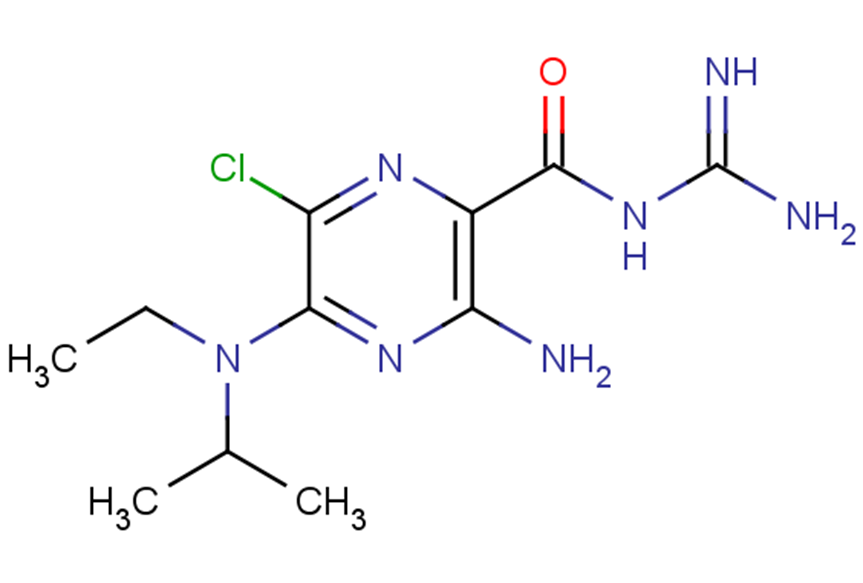
EIPA
CAS No. 1154-25-2
EIPA( L593754,MH 12-43 )
Catalog No. M22167 CAS No. 1154-25-2
EIPA (L593754, MH 12-43) is a TRPP3 channel inhibitor (IC50: 10.5 μM). It also inhibits Na+/H+-exchanger (NHE) and macropinocytosis.It is found that EIPA, benzamil, and phenamil rapidly and reversibly block Ca2+-activated TRPP3 channel activation at -50 mV, with IC50s of 143, 10.5, 1.1, and 0.14 μM, respectively.
Purity : >98% (HPLC)
 COA
COA
 Datasheet
Datasheet
 HNMR
HNMR
 HPLC
HPLC
 MSDS
MSDS
 Handing Instructions
Handing Instructions
| Size | Price / USD | Stock | Quantity |
| 2MG | 26 | In Stock |


|
| 100MG | Get Quote | In Stock |


|
| 200MG | Get Quote | In Stock |


|
| 500MG | Get Quote | In Stock |


|
| 1G | Get Quote | In Stock |


|
Biological Information
-
Product NameEIPA
-
NoteResearch use only, not for human use.
-
Brief DescriptionEIPA (L593754, MH 12-43) is a TRPP3 channel inhibitor (IC50: 10.5 μM). It also inhibits Na+/H+-exchanger (NHE) and macropinocytosis.It is found that EIPA, benzamil, and phenamil rapidly and reversibly block Ca2+-activated TRPP3 channel activation at -50 mV, with IC50s of 143, 10.5, 1.1, and 0.14 μM, respectively.
-
DescriptionEIPA (L593754, MH 12-43) is a TRPP3 channel inhibitor (IC50: 10.5 μM). It also inhibits Na+/H+-exchanger (NHE) and macropinocytosis.It is found that EIPA, benzamil, and phenamil rapidly and reversibly block Ca2+-activated TRPP3 channel activation at -50 mV, with IC50s of 143, 10.5, 1.1, and 0.14 μM, respectively. The number of autophagic vacuoles increases dramatically in the HAE and HPE groups after EIPA treatment compares with the HAN and HPN groups. EIPA regulates the initiation and maturation of the autophagy associated with amino acids in IEC-18 cells. In addition, the uptake of cinnamoylphenazine (CA-PZ) and neutral red (NR) is inhibited by EIPA.(In Vitro):EIPA (100 μM, 30 min) suppresses TRPP3-mediated Ca2+ uptake in X. laevis oocytes. EIPA hydrochloride (10-100 μM) reversibly inhibits the basal Na+ current (IC50: 19.5 μM). EIPA (300 μM, 6h) enhances autophagy through NHE3 (Na+/H+-exchanger 3) in IEC-18 cells. EIPA (20 μM, 2 h) blocks macropinocytosis-mediated uptake of CA-PZ massively entry in HT-29 cells and MIA PaCa-2 cells. EIPA (30 μM, 3h) attenuates Zinc/Kainate toxicity by decreasing Zn2+ entry in cerebellar granule neurons. EIPA (5-100 μM, 48h) suppresses proliferation of MKN28 cells through up-regulation of p21 expression. EIPA (3 μM, 6 h) inhibits the LPS-induced increase in the level of COX-2 protein.(In Vivo):EIPA (Intravenous injection, 1 mg/kg) dose-dependently attenuates the I/R (Ischemia/reperfusion)-induced renal dysfunction in ddY strain mice.EIPA (oral administration, 10 mg/kg) inhibits LPS-induced inflammation in air pouch-type LPS-induced inflammation model.
-
In VitroEIPA (100 μM, 30 min) suppresses TRPP3-mediated Ca2+ uptake in X. laevis oocytes.EIPA hydrochloride (10-100 μM) reversibly inhibits the basal Na+ current (IC50: 19.5 μM).?EIPA (300 μM, 6h) enhances autophagy through NHE3 (Na+/H+-exchanger 3) in IEC-18 cells.EIPA (20 μM, 2 h) blocks macropinocytosis-mediated uptake of CA-PZ massively entry in HT-29 cells and MIA PaCa-2 cells.EIPA (30 μM, 3h) attenuates Zinc/Kainate toxicity by decreasing Zn2+ entry in cerebellar granule neurons.EIPA (5-100 μM, 48h) suppresses proliferation of MKN28 cells through up-regulation of p21 expression.EIPA (3 μM, 6 h) inhibits the LPS-induced increase in the level of COX-2 protein. Cell Proliferation Assay Cell Line:MKN28 cells Concentration:5, 10, 25, 50, and 100 μM Incubation Time:48 h Result:Inhibited cell proliferation in a dose- and time-dependent manner.Western Blot Analysis Cell Line:IEC-18 cells Concentration:300 μM Incubation Time:6 h Result:Increased total LC3-II protein levels and P62 flux.
-
In VivoEIPA (Intravenous injection, 1 mg/kg) dose-dependently attenuates the I/R (Ischemia/reperfusion)-induced renal dysfunction in ddY strain mice.EIPA (oral administration, 10 mg/kg) inhibits LPS-induced inflammation in air pouch-type LPS-induced inflammation model. Animal Model:Male ddY strain mice Dosage:1 mg/kg Administration:Intravenous injection Result:Attenuated histologic renal damage, and imprved the I/R-induced increases in renal ET-1 contents.Animal Model:Air pouch-type LPS-induced inflammation modelDosage:10 mg/kg Administration:Oral administration Result:Inhibited the LPS-induced infiltration of leukocytes into the pouch.Inhibited the amount of PGE2 in the pouch fluid.
-
SynonymsL593754,MH 12-43
-
PathwayMembrane Transporter/Ion Channel
-
TargetTRP/TRPV Channel
-
RecptorTRPP3 channel| Na+/H+-exchanger (NHE)
-
Research Area——
-
Indication——
Chemical Information
-
CAS Number1154-25-2
-
Formula Weight299.76
-
Molecular FormulaC11H18ClN7O
-
Purity>98% (HPLC)
-
SolubilityDMSO:135 mg/mL (450.36 mM; Need ultrasonic)
-
SMILESCCN(C(C)C)c1nc(N)c(nc1Cl)C(=O)NC(N)=N
-
Chemical Name——
Shipping & Storage Information
-
Storage(-20℃)
-
ShippingWith Ice Pack
-
Stability≥ 2 years
Reference
1. Dai XQ, et al. Inhibition of TRPP3 channel by MK-870 and analogs. Mol Pharmacol. 2007 Dec;72(6):1576-85.
molnova catalog



related products
-
BI-749327
BI-749327 is a high selectivity and orally bioavailable antagonist of TRPC6 (IC50s: 13 nM, 19 nM and 15 nM for mouse, human and guinea pig TRPC6).
-
N4-benzyl-N2-methylq...
N4-benzyl-N2-methylquinazoline-2,4-diamine hydrochloride is an inhibitor of TRPC4.
-
JNJ-17203212
A potent, selective and orally bioavailable TRPV1 receptor antagonist with IC50 of 65 nM and 102 nM for hTRPV1 and rTRPV1, respectively.



 Cart
Cart
 sales@molnova.com
sales@molnova.com


